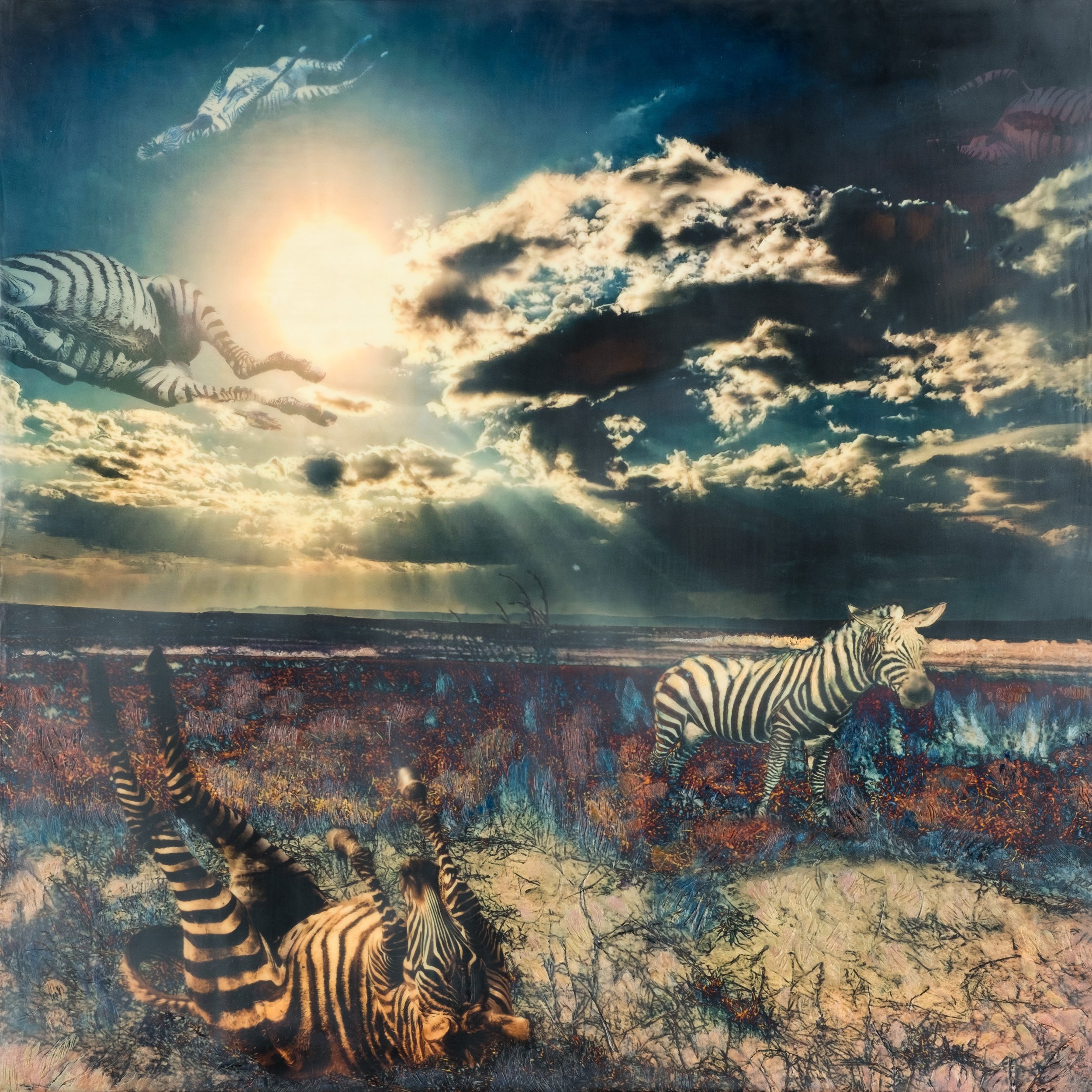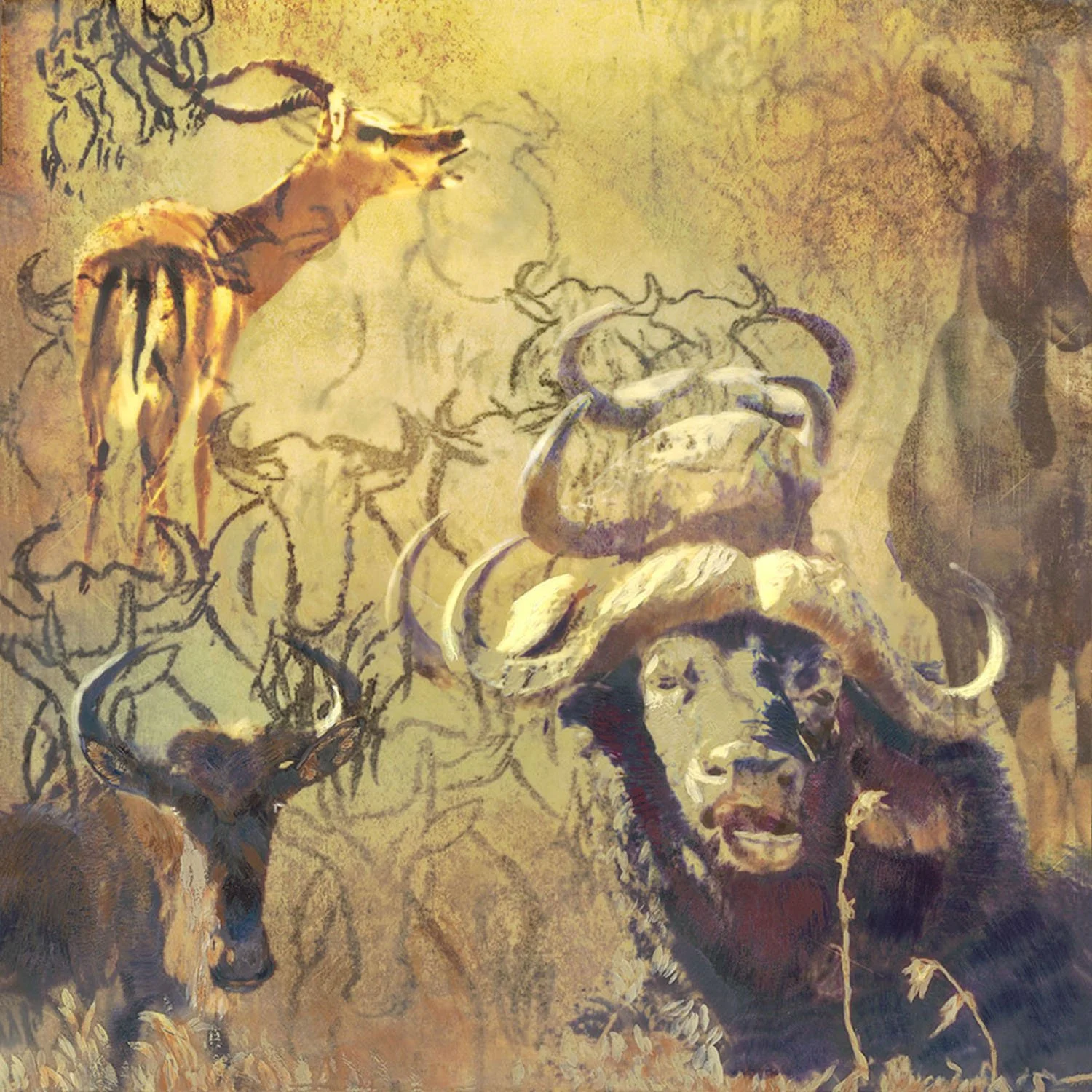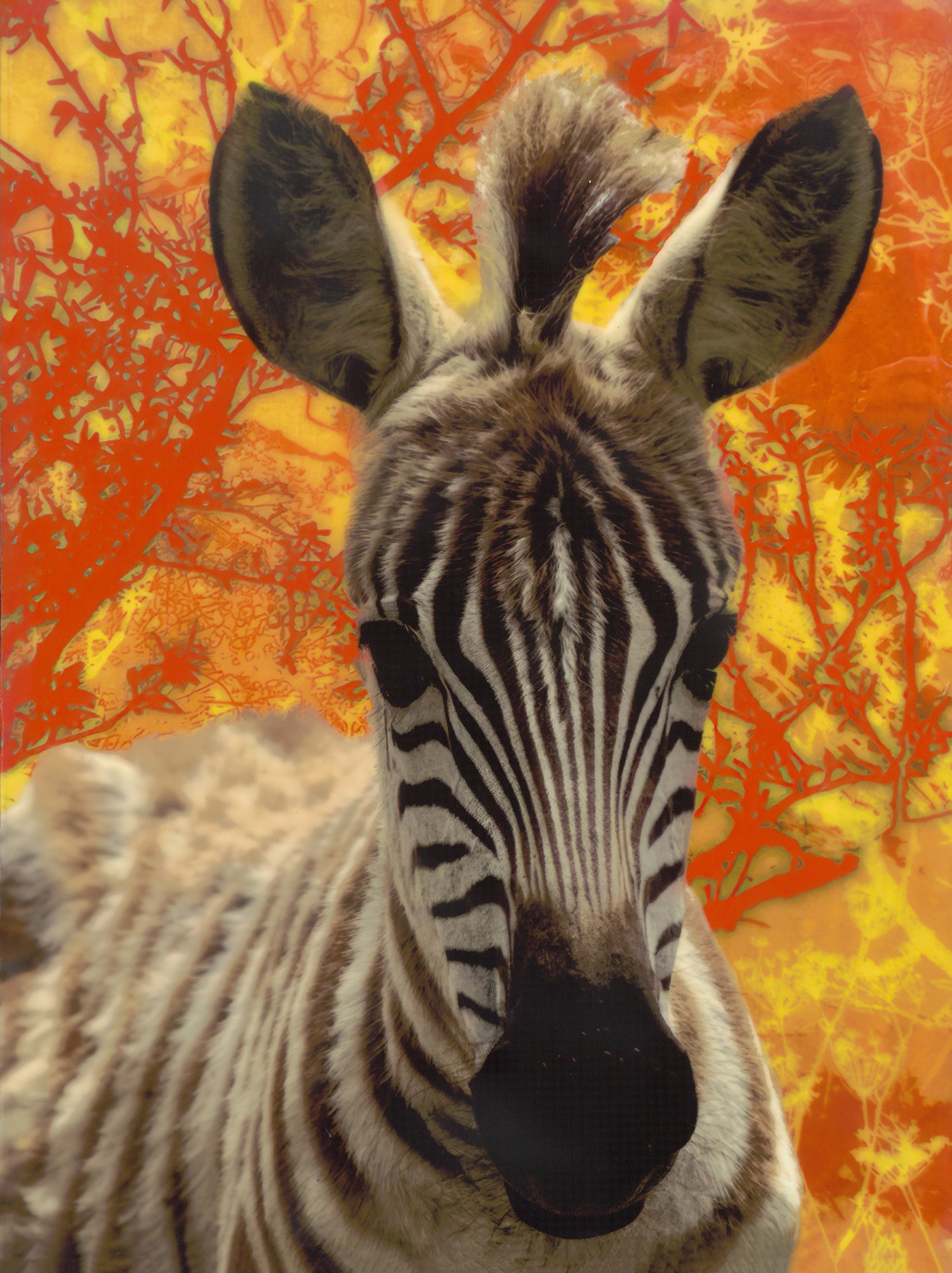Photo Encaustic
Dawn or Demise: Images from Sub-Saharan Africa
This series builds on my ongoing exploration of environmental themes through encaustic mixed media painting, using personal imagery and storytelling to reflect on ecological loss and resilience. Inspired by a trip to Kenya, the works highlights the escalating threats to East Africa’s wildlife—from climate change and habitat loss to poaching. One of the most haunting moments was witnessing the last two remaining northern white rhinos, pictured below in The Last Two Standing—both female and unable to reproduce—an encounter that underscores the urgency of conservation. Recent USAID funding cuts have further imperiled hard-won progress. To learn more about each image in this series, click the link below.
-
The Last Two Standing: This piece honors the two remaining northern white rhinos on Earth—both female and living under 24-hour armed guard at Kenya’s Ol Pejeta Conservancy, a renowned wildlife refuge in East Africa. During my visit, I was profoundly moved by their quiet presence and the stark reality of their situation: unable to reproduce naturally, they represent both devastating loss and a fragile thread of hope. Ol Pejeta’s collaboration with international scientists has led to the first-ever IVF rhino pregnancy, offering a potential lifeline for the species. The Last Two Standing reflects this emotional duality—grief for what we’ve lost and reverence for the resilience still possible through human care, innovation, and collective will.
Courage in Camouflage: Showcases the leopard, cheetah and giraffe’s beautiful coat patterns which all play significant roles in their survival strategies, yet these patterns which are an evolutionary miracle, cannot protect these animals from habitat loss due to human development and climate change.
Dawn or Demise: The horizontal stripes at the bottom of this image are a climate data visualization known as “warming stripes,” illustrating global temperature changes from 1850–2022. Each stripe represents a year: blue for cooler-than-average, red for warmer. The deep red bands on the right reflect the planet’s rapid heating in recent decades. This graphic was created by Professor Ed Hawkins, University of Reading, England.
Poaching Memories: Elephants Never Forget: The vertical “biodiversity stripes” on the left side of Poaching Memories visualize global biodiversity loss over time. Bright green represents high biodiversity; yellow to dark grey indicates declining levels. Since 1970, populations of mammals, birds, fish, amphibians, and reptiles have dropped by an average of 69% globally, based on data from over 30,000 populations. Created by Professor Miles Richardson from the University of Derby in England, the stripes highlight the urgent need to address both climate change and wildlife loss to ensure a “livable planet for future generations.”
Patterns of Dystopia: This image imagines a climate-altered world where animals are displaced from their habitats, evoking the desolation of an apocalyptic landscape. For more information on the impact of climate change on zebras specifically, please see description for On High Alert.
Cheating Fate: Cheetahs in East Africa are increasingly vulnerable to climate change, which amplifies many of the pressures they already face. Rising temperatures and prolonged droughts reduce the availability of prey species, forcing cheetahs to roam farther and expend more energy to find food. At the same time, shrinking water sources and shifting vegetation patterns fragment their already-limited habitat, making it harder for them to maintain viable territories.
Defending Lascaux: The Cape buffalo, Topi, and other horned animals roaming Kenya’s grasslands evoke a primal connection to the ancient past—echoes of creatures etched into the walls of the Lascaux caves over 17,000 years ago. These powerful forms, once sacred symbols of survival and mystery, now stand at the frontlines of a rapidly changing climate. As their habitats shrink and seasonal patterns shift, these icons of endurance face new existential threats. The same animals that stirred awe in early humans now remind us—across millennia—of our shared fragility and the urgent need to protect the natural world before these living symbols, too, fade into myth.
Facing the Climate Puzzle: Lions are vital indicators of ecosystem and human health across Africa. In twenty years, their population has declined 50%, impacting over 300 million people in Sub-Saharan Africa whose livelihoods are dependent upon clean water, food security, and resilience to natural disasters that is associated with protected lion habitats, or “lionscapes”. The CEO of the African Wildlife Foundation believes “lionscapes…are the most important national asset.” Conserving lions isn't just about saving a species—it’s about sustaining the natural systems that support the economic and societal well-being of the African continent.
Fragmentation: Habitat fragmentation is a growing threat to Kenya’s waterbucks, whose survival depends on access to water and open grasslands. As farmland, roads, and settlements expand, these antelopes are increasingly confined to isolated patches of habitat, limiting their ability to roam, find food, and access water sources. Fragmentation also heightens their vulnerability to predators and poaching, while reducing genetic diversity due to restricted movement between populations. Conservation areas like Ol Pejeta offer crucial refuge, but broader habitat connectivity is essential for long-term resilience.
Numbered Days: In East Africa, rapid development and human encroachment are shrinking and fragmenting natural habitats, forcing baboons and other primates into closer contact with people. As forests are cleared for agriculture and infrastructure, primates lose access to food, shelter, and safe migration routes. This not only increases human-wildlife conflict but also exposes primates to disease and poaching. Climate change compounds these pressures by altering fruiting and flowering patterns, making food sources less predictable and further stressing already vulnerable populations.
On High Alert: In East Africa, all three zebra species—Plains, Mountain, and Grevys—are increasingly vulnerable to the effects of climate change. Prolonged droughts and shifting rainfall patterns are reducing the availability of water and forage, forcing zebras to travel farther for resources and increasing their risk of conflict with humans and livestock. Mountain zebras, adapted to cooler high-altitude habitats, face habitat loss as temperatures rise. Grevys zebras, the most endangered of the three, have seen a 54% population decline over the past three decades, with only about 2,800 remaining. Their already limited range has shrunk due to competition with livestock, habitat fragmentation, and now more frequent droughts—further threatening their survival.
Topsy Turvy: For more information on the impact of climate change on zebras specifically, please see description for On High Alert.
Vanishing Rosettes: Climate change is impacting leopards in Kenya by altering their prey availability, water sources, and suitable habitats. Prolonged droughts reduce populations of herbivores that leopards rely on for food, forcing them to venture closer to human settlements in search of sustenance—leading to increased conflict and retaliatory killings. Shifting climate zones and rising temperatures also fragment their natural habitats, making it harder for these elusive predators to roam and hunt effectively. Combined with habitat loss from agriculture and development, climate-driven stress puts additional pressure on already declining leopard populations.
Ostrich Mating Dance: Ostriches, though well-adapted to dry climates, face heat stress, shrinking habitats, and lower breeding success as temperatures rise and landscapes degrade. These shifts reflect the broader fragility of East Africa’s ecosystems.
Lake Elementaita’s Flamboyant Flamingos: Flamingos rely on East Africa’s alkaline lakes, but climate change is disrupting water levels, reducing algae—their main food source—and making lakes increasingly toxic.
Kambu, Kenya’s Proud National Bird: The lilac-breasted roller—known as Kambu in Swahili—is a striking bird with eight vivid colors in its plumage, symbolizing the rich diversity of Kenya’s many tribes and ethnicities. In some Kenyan cultures, the Kambu represents peace and reconciliation and is associated with the ability to unite communities making it a meaningful symbol in today’s politically divided world. Additionally, the Kambu is known for its fearlessness, making it a potent role model for those who wish to stand up to authoritarianism and defend justice with courage.
Yellow-bellied Nectar Loving Sunbirds: Climate change is putting species like the lilac-breasted roller and the variable sunbird at risk. Shifting weather patterns are altering the availability of flowers and insects—critical food sources for these birds. Rising temperatures and habitat loss are also disrupting their breeding and migration cycles, placing additional stress on populations already threatened by environmental change.
Succulent Series
Natural World
Built Environments









































